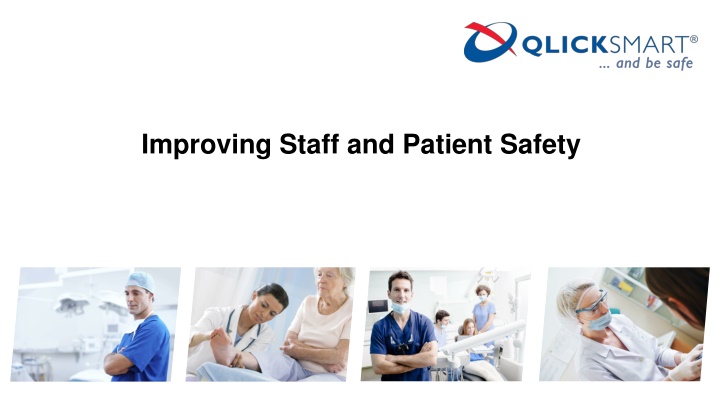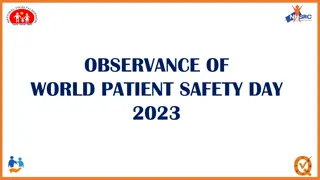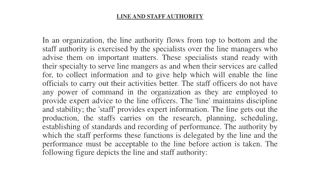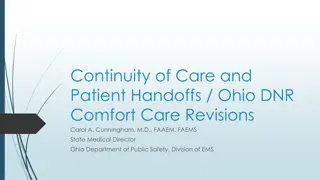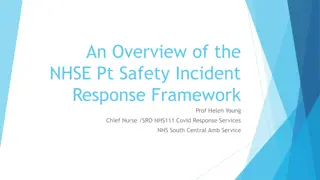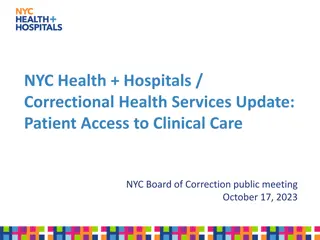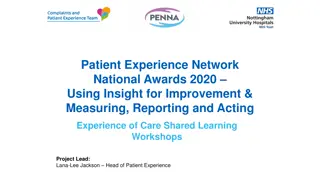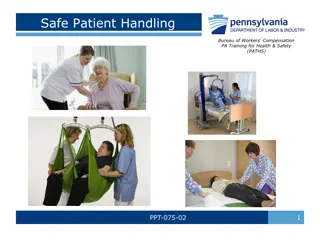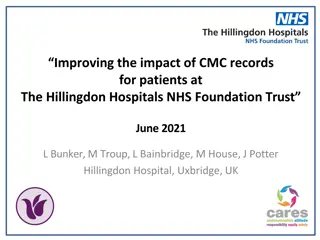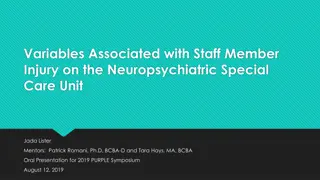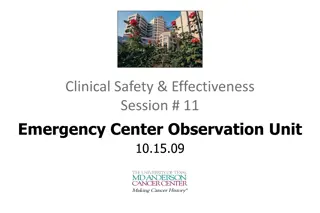Improving Staff and Patient Safety: Recent Progress and Challenges
Patient safety has been a critical focus in healthcare, spurred by the landmark "To Err is Human" report. Despite progress since 1999, challenges remain in addressing medical errors and enhancing safety for both staff and patients. The interconnected nature of worker safety and patient safety highlights the importance of creating a safe environment to mitigate risks. This ongoing journey involves evolving practices, shaping hospital cultures, and embracing proven safety measures to protect all involved in healthcare settings.
Download Presentation

Please find below an Image/Link to download the presentation.
The content on the website is provided AS IS for your information and personal use only. It may not be sold, licensed, or shared on other websites without obtaining consent from the author.If you encounter any issues during the download, it is possible that the publisher has removed the file from their server.
You are allowed to download the files provided on this website for personal or commercial use, subject to the condition that they are used lawfully. All files are the property of their respective owners.
The content on the website is provided AS IS for your information and personal use only. It may not be sold, licensed, or shared on other websites without obtaining consent from the author.
E N D
Presentation Transcript
Patient Safety: To Err is Human report In 1999, the Institute of Medicine released a report called To Err is Human: Building a Safer Health System. This report highlighted the problem of medical errors, while calling to make healthcare safer for patients Proposed changes to the culture of hospitals: No-blame culture for staff who make an error Focus on patient safety within all aspects of care Recommendations for hospitals: Establishing a national Patient Safety Centre to enhance the knowledge base about safety Implementing periodic re-examinations and re-licensing Paying special attention to the safe use of drugs and using proven medication safety practices. Designing and improving reporting systems Safety as the focus, including training for staff Kohn, Corrigan, Donaldson, Institute of Medicine . Committee on Quality of Health Care in America, & ProQuest. (2000). To err is human : building a safer health system. Washington, D.C.: National Academy Press.
Patient Safety: Timeline of progress 1999 2009 2014 2019 To Err is Human report is released, with intention to implement positive change. Patient safety is found to be getting worse. Some improvement is seen to be made, however more is required. Further improvements are found in specific areas (eg. central line associated bloodstream infections). 1 in 7 hospitalized Medicare patients (USA) experience 1 or more adverse events. 1 in 10 hospitalised patients experience an adverse event, 80% of which are preventable (USA). Healthcare Research and Quality Act of 1999 is signed by President Clinton to address patient safety concerns (USA). Implementation of safety tools and practices is considered inconsistent. Kohn, Corrigan, Donaldson, Institute of Medicine . Committee on Quality of Health Care in America, & ProQuest. (2000). To err is human : building a safer health system. Washington, D.C.: National Academy Press. | Clancy, C. M. (2009). Ten Years After To Err Is Human. American Journal of Medical Quality, 24(6), 525-528. doi:10.1177/1062860609349728 | National Patient Safety Foundation. (2015). Free from Harm: Accelerating Patient Safety Improvement Fifteen Years after To Err is Human. | Bates, D. W., & Singh, H. (2018). Two decades since To Err Is Human: an assessment of progress and emerging priorities in patient safety. Health Aff (Milwood), 37, 1736-1743
Patient Safety: What was missed? The relationship between staff safety and patient safety is misunderstood, and was not considered by many hospitals when deciding on improvements. Second, worker safety is often linked with patient safety. If workers are safer in their jobs, patients will be safer also. Sometimes, the actions needed to improve patient safety are ones that would also improve worker safety. Procedures for avoiding needlesticks or limiting long work hours are aimed at protecting workers but can also protect patients. Thus, although worker safety is not the focus of this report, the committee believe that creating a safe environment for patient will go a long way in addressing issues of worker safety as well. (page 24) Kohn, Corrigan, Donaldson, Institute of Medicine . Committee on Quality of Health Care in America, & ProQuest. (2000). To err is human : building a safer health system. Washington, D.C.: National Academy Press.
Staff Safety: How the perspective has evolved 1999 perspective To Err Is Human (USA) Patient Safety Staff Safety One-way relationship: Focusing on patient safety initiatives will improve staff safety Late 00 s perspective 2008 Staff and Patient Safety established (Australia) 2009 Ivy Business Journal study (Canada) 2011 BMJ Article (Sinnott and Shaban) Patient Safety Staff Safety Two-way relationship: Focusing on staff & patient safety initiatives will improve patient & staff safety Kohn, Corrigan, Donaldson, Institute of Medicine . Committee on Quality of Health Care in America, & ProQuest. (2000). To err is human : building a safer health system. Washington, D.C.: National Academy Press. | http://staffandpatientsafety.org/au/home.htm | Sikorski, J. (2009). Connecting Worker Safety to Patient Safety: A New Imperative for Health-Care Leaders. Ivy Business Journal(January/February 2009). | Sinnott, M., & Shaban, R. (2011). Can we have a culture of patient safety without one of staff safety? British Medical Journal, 342(c6171).
Staff Safety: Public Citizen 2013 Report (USA) This report analysed injuries to healthcare workers compared to injuries to workers in other industries. Rates of injuries to nurses (per 10,000 workers) Nurses All Workers Musculoskeletal 249 34 Violence/Assault 27.2 3.8 Rates of injuries involving days spent away from work (per 10,000 workers) Healthcare Manufacturing Construction 76 78 80 82 84 86 88 90 92 94 PublicCitizen. (2013). Health Care Workers Unprotected - Insufficient Inspections and Standards Leave Safety Risks Unaddressed. Retrieved from https://www.citizen.org/wp- content/uploads/health-care-workers-unprotected-2013-report.pdf
Translation Into Practice: A 5-Step Process to Improve Sharps Safety PROCESS IDEA CLINICALPRACTICE
Sharps Safety Translation: Awareness (Step 1) Building public and professional awareness of staff safety concerns is critical. Research into patient safety matters increased dramatically since To Err Is Human, but there is much research to be done regarding staff safety matters. Public awareness of the problem can encourage government attention, regulatory change, and hospitals to improve.
Sharps Safety Translation: Regulatory Support (Step 2) There are sharps safety regulations and standards around the world. These include: Australian/New Zealand Standard AS/NZS 3825:1998 (Australia, New Zealand; 1998) Needlestick Safety and Prevention Act (USA; 2000) Revision to OSHA s Bloodborne Pathogens Standard (USA; 2001) European Council Directive 2010/32/EU (Europe; 2010)
Sharps Safety Translation: Safety Equipment (Step 3) Compliant with OSHA requirements Prevent high-severity risk and associated costs Prevent hospital-associated infection and/or injury (to healthcare worker) Easy implementation into current practices Scalpel Blade Removers Support culture of safety for patients and staff Choose best-suited product based on needs
Sharps Safety Translation: Safety Equipment (Step 3) Prevent disruption to patient care Prevent high-likelihood risk and associated costs Reduce drug wastage from shattered glass Easy implementation into current practices Ampoule Openers Support culture of safety for patients and staff Choose best-suited product based on needs + low product lifetime cost
Sharps Safety Translation: Administrative Actions (Step 4) Administrative Actions are the policies and habits hospitals implement to improve sharps safety. These can include: Employee education programs on how to avoid sharps injuries Policies regulating safety equipment use and reporting injuries Quality improvement committee to review policies and their effectiveness Safety score card (Find at: www.staffandpatient safety.org)
Sharps Safety Translation: Management Support (Step 5) A supportive leadership and management is a vital part of creating a safety culture. A major reason why healthcare staff don t speak up over safety concerns is that they believe the organisation s hierarchy is intimidating and/or unsupportive. Burnout occurs frequently among healthcare staff, and has been positively associate with poorer patient safety and satisfaction. Management can combat Burnout by focusing on improving the wellbeing of staff physical professional social psychological Manapragada, D., & Bruk-Lee, V. (2016). Staying silent about safety issues: Conceptualizing and measuring safety silence motives. Accident Analysis & Prevention, 91(June 2016), 114-156. | Allespach, H., Sleeman, D., Pust, G. D., & Schulman, C. I. (2016). Enhancing Surgeon Wellness: Integrating a Multidimensional Behavioral Medicine Approach into a General Surgery Residency Program. Resources in Surgical Education.
Sharps Safety Translation: Summary Research for sharps injury occurrence Public education on the risks of sharps injuries Advocacy groups 1. Awareness Legislation and professional guidelines Eg. Infection Control Guidelines 2. Regulatory Support Passive (automatic) safety-engineered devices Eg. retractable safety syringe, single-handle scalpel blade remover 3. Safety Equipment Regular training on sharps compliance and equipment Reporting system for incidents Committee to review sharps procedures Safety scorecard 4. Administrative Actions Support to injured worker Encourage positive language around improved practices Listen to sharps concerns and improve staff wellbeing 5. Management Support
Benefits of Investing in Staff Safety A systematic focus on safety has been reported to have the following flow-on effects: Increased quality of patient care and service Efficient patient flow Decreased absenteeism and overtime Reduced lost time (caused by injuries or sickness) Reduced need for agency staff (lower costs) Higher staff retention Improved communication and teamwork Higher work satisfaction and productivity A healthier, stable workforce Sikorski, J. (2009). Connecting Worker Safety to Patient Safety: A New Imperative for Health-Care Leaders. Ivy Business Journal(January/February 2009). | all, L. H., Johnson, J., Watt, I., Tsipa, A., & O Connor, D. B. (2016). Healthcare Staff Wellbeing, Burnout, and Patient Safety: A Systematic Review. PLOS ONE, 11(7), e0159015. doi:10.1371/journal.pone.0159015 | Black C. Why healthcare organisations must look after their staff. Nursing management (Harrow, London, England : 1994) 2012;19(6):27-30. doi: 10.7748/nm2012.10.19.6.27.c9319
